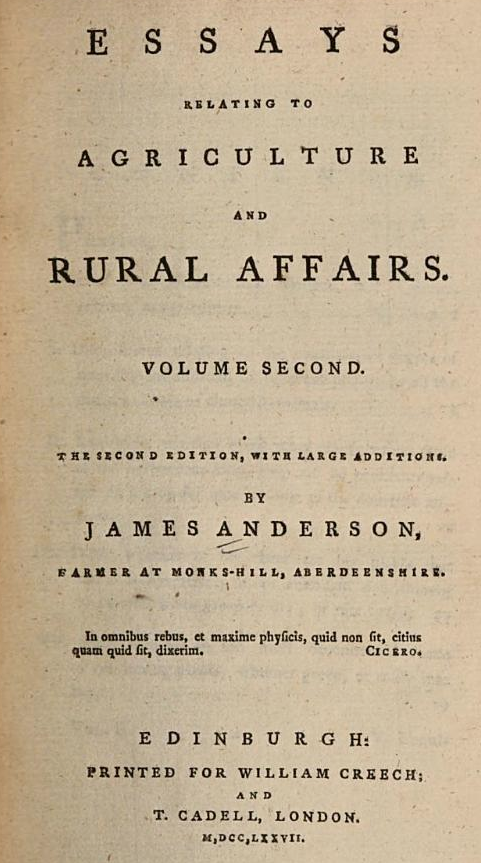
Essays relating to Agriculture and Rural Affairs, Volume Second, The Second Edition, by James Anderson, Farmer at Monks-Hill, Aberdeenshire, Edinburg, 1777—A misquoted reference in the lineage of rational, rotational and planned grazing
By Darren J. Doherty, CPAg (AIA)
James Anderson (1739-1808) of Monks Hill, Aberdeenshire (UK), was a Scottish farmer, inventor, economist and journalist, who in 1777 published a wonderful set of volumes outlining some of his experience and vision for agricultural management and development titled, Essays relating to Agriculture and Rural Affairs. As I am in the midst of researching and writing the Planned Grazing section of the 8•Soils chapter of the Regrarians Handbook, my starting point led me to indulge in my enduring interest of attempting to establish the lineages of concept development. In this case this lead me to reading these quite outstanding volumes of Mr. Anderson and gaining a better understanding of his life and those he also influenced.
Anderson’s Essays were well received as The Monthly Review or Literary Journal of 1778 (Volume 58) suggests:
“…it seems to be well calculated for inducing the Reader to think and reason for himself, for as to be able to proceed with profit, after the book which has directed him into the right path is totally forgotten . The Author has evidently studied agriculture with a more than ordinary degree of application. Hints frequently occur that will employ the researches of future age…”
Though the same review closed with a pejorative statement that the pompous English writer sought fit to level at this practical intellectual of a Scot:
“…It is also recommended to him to get some English friend to expunge the numerous Caledonianisms…”
It is noteworthy that these essays these ‘hints’ to ‘employ the researches of future age (s)’ where considered by three giants of the next two centuries including Friedrich Engels (1820-1895) and Karl Marx (1818-1883), where ‘the conflict between tenant farmer and landed proprietor over investment in agricultural improvements, which was to become a central element of Marx’s critique of capitalist agriculture in Britain’ (3).
Perhaps curiously, the third giant was the famous French farmer, soldier and biochemist André Voisin (1903-1964), where in his pivotal and highly influential tome, Grassland Productivity: An Introduction to Rational Grazing (1957), Voisin cited Anderson’s ‘constant rotation’ of livestock as a ‘mode of management’, along with that of three of his countrymen, the agronomist Alexandre-Henri Tessier (1741-1837), and botanists André Thouin (1747-1824) and Louis Augustin Guillaume Bosc (1759-1828) and their six volume, Methodical Encyclopedia of Agriculture (1760), where similar grazing concepts were discussed (see addendum to this article). I say ‘curiously’ as it is not without notice that Voisin spent his last years in Cuba as the guest of no less than the late Fidel Castro (1926-2016).
Anderson’s essays and his name are frequently referenced as being the source of some of the first mentions of the concept of ‘rotational grazing’. When reading the chapter where a kind of rotational grazing is promoted for experimentation, it is clear that the most commonly quoted paragraph does not exist—rather it is a paraphrased composite of sentences—the text of this composition is as follows:
“Animals delight most to feed on fresh plants. Cattle supplied with this kind of food would be quickly fatted. If a farmer divided his land into 15-20 equal divisions, stopped his beasts from roaming indiscriminately, put the whole number of his beasts into one of these divisions, have the number of beasts so great as to consume the best part of the grass in one day, give them a fresh park each morning to repeat the same repast, have so many parks as days required to advance the grass to the proper length after being eaten fare down so the first field would be ready to receive them after going over all the others, thus they might be carried round in a constant rotation.”
In order to capture Anderson’s vision and to enable greater context, it is useful to read the chapter in which this concept is a central element rather than just this cherry-picked statement. I have transcribed this text so as to make it more easily understood by the modern reader. I have also also included copies of the original pages so as to honour the original reference.
XXXVI. Enquires into what may be the most economical manner of consuming the produce of pasture fields.
What is the most economical manner of consuming the produce of any pasture-field? That is to say—Whether ought the animals who are feed upon it to be turned upon it at large and be allowed there to remain without any change of pasture for the whole season: or ought they rather be be kept upon it only for a short time, and then carried to another: or in what other way ought they to be treated, so as to turn out the greatest profit to the possessor?
The practice that in general prevails throughout the greatest part of Britain in rich enclosed pastures, where domestic animals are intended to be fattened for the butcher is, to turn the whole number of beasts that it is supported the field could properly maintain into it in the beginning of summer, where they are allowed to go at their own ease all the remaining part of the season, without any change of pasture at all. And although many have been accustomed to practice this method are very positive in their assertions, that it is the most economical mode of consuming their pastries that could be practiced, yet, as I do not find they support this assertion with any decisive experiments, there seems to be many reasons to us doubt if the fact is as they assert, as to make us, at least, suspend our opinion till the necessary experiments shall be fairly made, so as to ascertain this point with precision.
For, as the greatest part of the common grasses grow more quickly during the beginning of summer than they do after the season is farther advanced; if we were to attempt to put nearly as many beasts into the field as would be sufficient to eat up all the grasses that advance at that period, they would not have half food during the remaining part of the season. To avoid this inconvenience, therefore, it becomes necessary to put only as many beasts at the time into the field as can be afterwards maintained in it properly, so that many plants must then be suffered to run to seed: after which no animal will taste them, unless constrained by hunger. Many more are, at this period trod down by the feet of the beasts in their wanton gambols, which are never afterwards relished by them. And, as it has already been demonstrated, p. 38. Vol.II. that many plants soon attain to a certain length, beyond which they never advance, if not eat down or cropped; the whole vegetation of the field must be stopped, and the total produce of it throughout the whole season be greatly diminished from what it might perhaps have been by a more skilful management.
And if, with the a view to remedy, in some measure, this inconvenience, a greater number of beasts should be put into the field during the beginning of summer than towards the end of it, we would indeed, in some measure, diminish the evil, the not effect a radical cure. For if the field were at that season eat so bare as to prevent any plants from running to seed, there would be some room to dread that the animals would be too much stinted for food to fatten kindly. And as the grasses upon which they have lately breathed is, in general, disagreeable to them, it is much to be doubted if they would come so quickly into flesh as would abundantly reward the hopes of the husbandman.
From these considerations, it would seem probable, that there must always be a considerable waste of food by this mode of management, let the farmer be as attentive as possible; which, it is imagined, might in great measure be prevented by the following, or some similar practice.
As every kind of animal delights most to feed upon fresh plants that have newly sprung up from the bare surface, in which there is no decayed or rotted stalks of any kind: there is little doubt but that, if cattle that are intended to be fatted were always supplied with a constant succession of this kind of food, they would be brought forward in flesh as the nature of that food could in case do it.
To obtain this constant supply of fresh grasses, let us suppose that a farmer who has any extent of pasture ground, should have it divided into fifteen or twenty divisions, nearly of equal value: and that, instead of allowing his beasts to roam indiscriminately through the whole number at once, he collects the whole number of beasts that he intends to feed into one flock, and turns them all at once into one of these divisions; which, being quite fresh, and of sufficient length for a full bite, would please their palate so much as to induce them to eat of it greedily, and fill their bellies before they thought of roaming about, and thus destroying it with their feet. And if the number of beasts were so great as to consume the best part of the grasses of one of their enclosures in one day, they might be allowed to remain there no longer:—giving them a fresh park every morning, so as that the same delicious repast might be again repeated. And if there were just so many parks as there require days to make the grasses of these fields advance to a proper length after being eat bare down, the first field would be ready to receive them by the time they had gone over all the others; so that they might be thus carried round in a constant rotation.
But, as it would be necessary to allow his fattening beasts always to have a full bite, it would not be proper to keep so many of these as would at any time eat any of these fields quite bare.—And as the grasses that they would thus leave behind them would, in part, run to seed before they could return to the field, while some other parts of it would be withered, or half rotted, pastures would be thus rendered less sweet and nourishing than they would otherwise have been.—And as there would likewise be a smaller quantity of grasses produced on the field in this way than if it had been eat quite bare to the ground, it would be great want of economy in the farmer not to keep another set of young or lean beasts which should regularly succeed the rest, so as to make it quite bare, and put it in a proper condition for vegetating again with vigour. And as it would be always in his power to augment or diminish this last stock, as circumstances might require, by keeping a few supernumeraries in some spare field, or by buying in others; it would seem that he would thus have a probability of reaping the full benefit of every blade of grass that would be reared upon the field:—more specifically if the circumstances mentioned in the following disquisition were duly attended to.
There is no doubt, however, that cattle, when allowed to roam at large on an extensive field, will fatten very kindly if they have a sufficient quantity of food: But the question at present is, Whether the same field will feed to perfection a greater number of beasts in the or other mode of managing it? The subject is of importance, and deserves to be elucidated by proper decisive experiments.
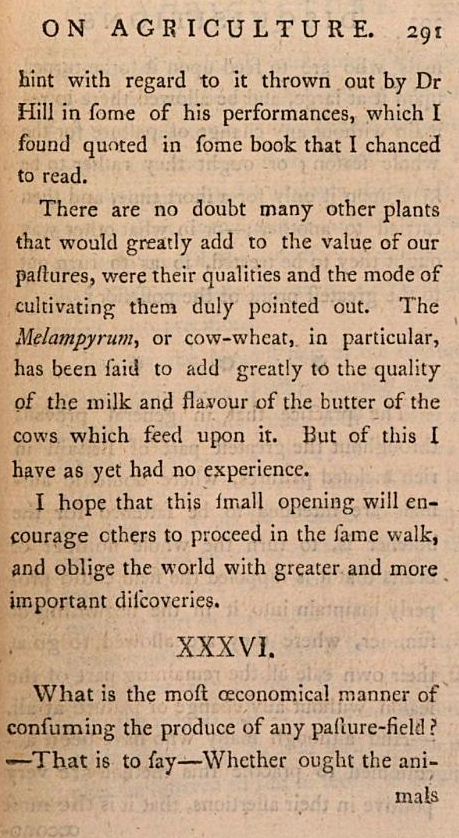
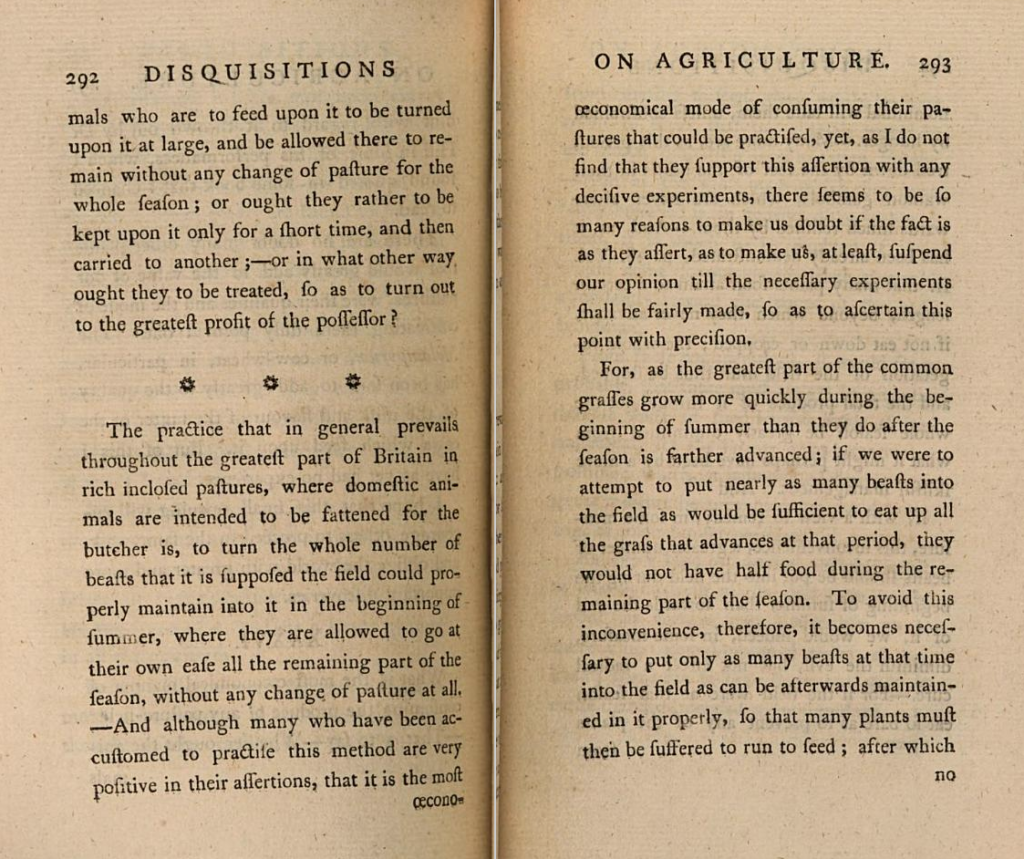
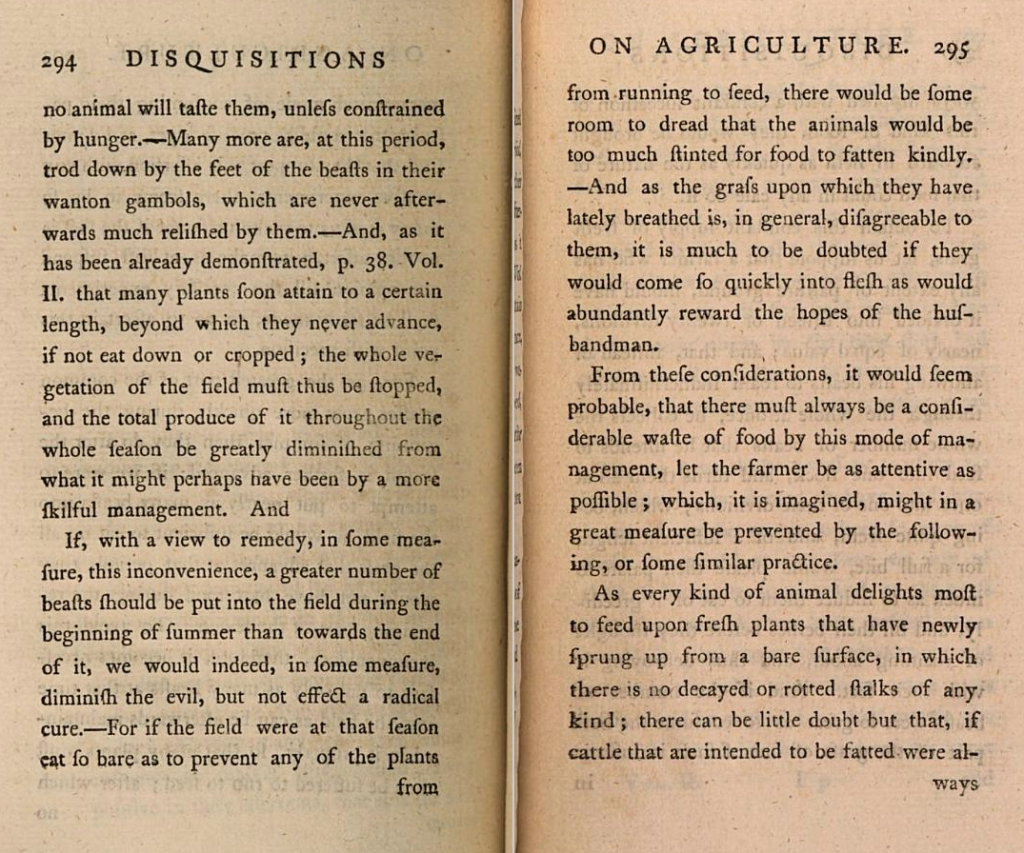
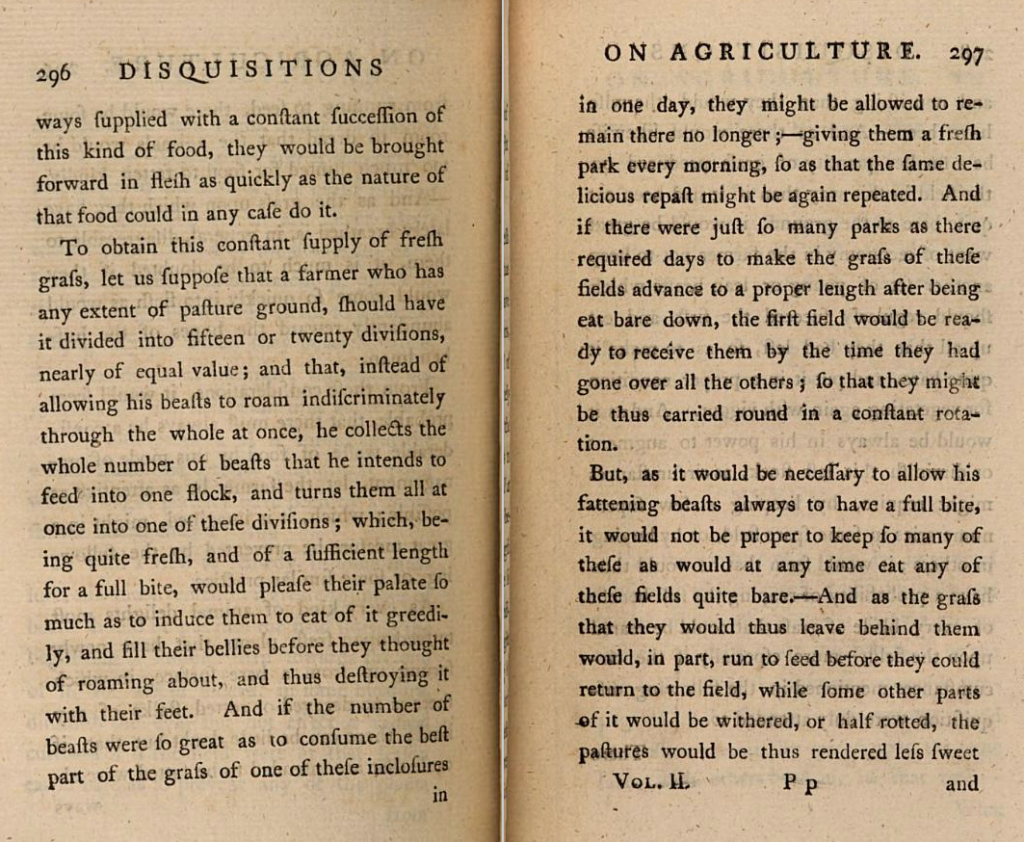
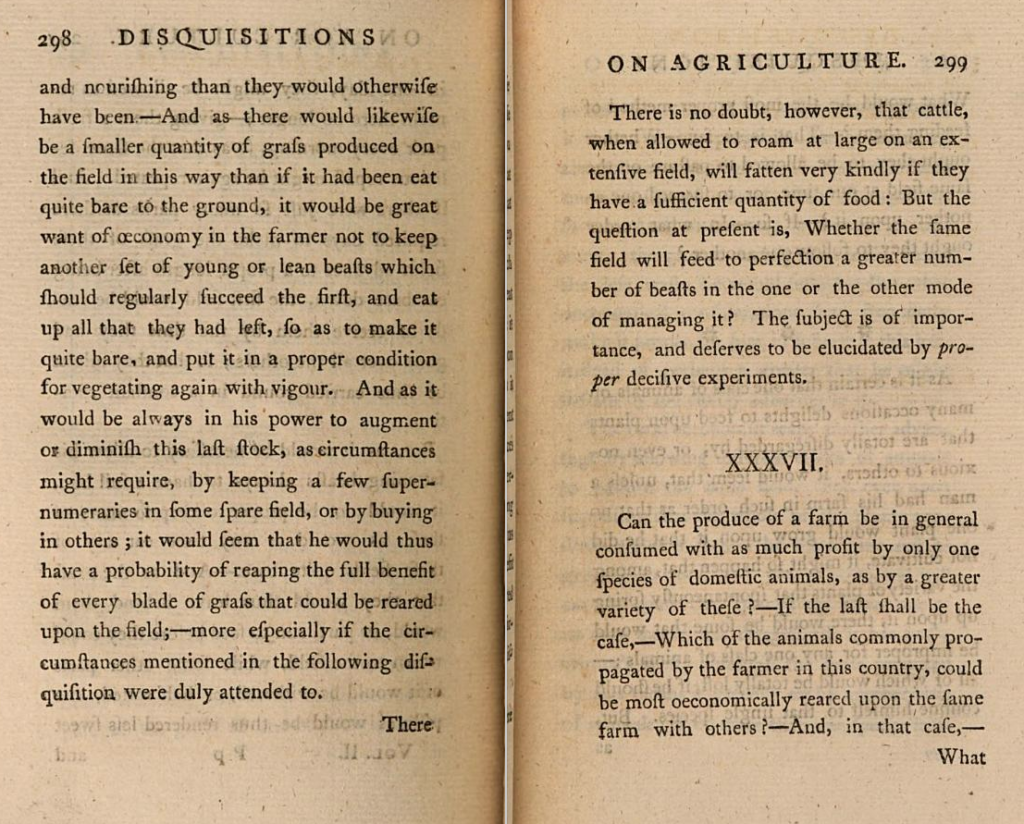
Addendum
The Mssrs. Tessier, Thouin and Bosc and their Methodical Encyclopaedia of Agriculture (1760) were quoted in Grass Productivity (1957) by André Voisin with the inclusion of the following page:
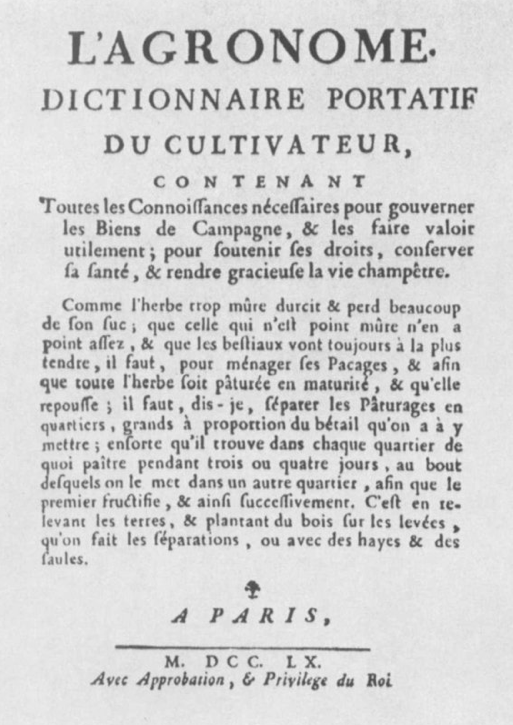 I transcribed this text into a more modern French as follows,
I transcribed this text into a more modern French as follows,
Toutes les connoissances necessaire pour gouverner les biens de campagne, & les saire voloit utilement; pour foutenir fes droits, conserver sa santé, & rendre gracieuse la vie champetre.
Comme l’herbe trop mûre durcit & perd beaucoup de son suc; que celle qui n’est point mûre n’en a point assez , & que les bestiaux vont toujours á la plus tendre, il faut, pour ménager fes Pacages, & asin que toute l’herbe foit pâturée en maturité, & qu’elle repousse; il faut, dis-je, séparer les Pâturages en quartiers, grands á proportion du bétail qu’on a á y mettre; enforte qu’il trouve dans chaque quartier de quoi paître pendant trois ou quatre jours, au bout desquels on le met dans un autre quartier, asin que le premier sructifie, & ainsi successivement. C’est en relevant les terres, & plantant du bois sur les levées, qu’on sait les séparations, ou avec des hayes & des saules.
Thanks to André Voisin’s ‘Grass Productivity: An Introduction to Rational Grazing for the following translation:
All the knowledge necessary to govern the goods of the countryside, and if they were usefully stolen; to keep your rights, to preserve your health, and to make country life graceful.
Grass that is too mature becomes hard and loses much of feeding substances. Grass that is not mature does not possess enough of these substances. As beasts always go to the most tender herbage, it is essential when managing grassland, so that all the grass will be grazed at maturity and re-grow, that the pastures be divided up into sections, the size of which is in proportion to the number of beasts they are to carry; the aim being that each section contains sufficient keep for three or four days, after which the stock are put on to another section so that the first can bear fruit. Division is achieved by banking up the soil and planting trees on top, or by hedges and willow trees”
.
